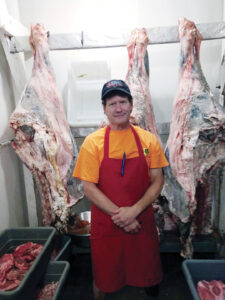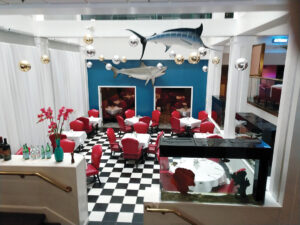‘Death Moans’ no more: Food and civic esteem in Des Moines
6/1/2022
This Victorian mansion was home to Chat Noir, Cafe di Scala and Aposto
Webster defines pride as “a feeling of deep pleasure or satisfaction derived from one’s own achievements, the achievements of those with whom one is closely associated, or from qualities or possessions that are widely admired.” The secondary meaning is “consciousness of one’s own dignity.” A tertiary meaning is “a social group of lions.” Afterall, the lion is the king of the jungle, so why wouldn’t a gathering of kings be proud?
What creates civic pride? Anyone who has ever been to Green Bay in the fall would answer sports teams. But no other city has a loyalty to a team like Green Bay does. The team is publicly owned by citizens. University towns feel similar pride in the achievements of their schools, sports and other wise. Alumni donations rise dramatically when a school wins a big title. Small towns and suburbs are similarly involved with their high schools.
Some cities have similar pride in the glory of their museums. Florence, Paris, New York, Washington, London, St. Petersburg, Madrid, Mexico City, Xi’an, Agra, Gettysburg, San Antonio and Marfa, Texas, are at the top of that list. Other places pride themselves on singular associations with great people. Hodgenville, Kentucky, and Springfield, Illinois, both claim Abraham Lincoln and even Van Buren County, Iowa, makes spurious claims that he visited there courting Ann Rutledge.
Nothing is as universally inducive of pride — individual, civic and national — as good food. Food taboos in Hinduism, Judaism, Islam, Jainism and even Buddhism double down on the pride or shame people feel about what they eat. Many wars in history were motivated by one tribe wanting to steal the foods of another tribe.
No place on Earth has been victimized more frequently by wars of food lust than Champagne, France. Half the region’s wineries have secret underground hideaways, not for people, but for sparkling wine. German and French armies have taken and retaken the province more times than even winery owners can count. Iowa and Missouri engaged in a three-day “honey war” to determine which state owned a honey-rich area on the border. That war was decided in Iowa’s favor by the U.S. Supreme Court.
Wars over fishing waters have been continuous since the invention of war ships. Unlike most other food raiders, fish thieves are alive and rampant today. They are considered smugglers as nasty as drug dealers, sex traders and child slavers. Spanish, particularly the mafia of Vigo, and Chinese pirates are the worst, but at least six other nation’s ships have been nabbed in the act. Some smugglers have been caught stuffing illegal drugs into illegal fish bladders. Main victims are West Africa and Norway. The latter nation told the United Nations they “haddock enough of it.”
The Roman Empire was the greatest siezer of good food ever. The Romans, often considered to be the greatest gourmets and gluttons of history, stole hams from Belgium, oysters from Brittany, wild game from Tunisia, silphium (a seasoning and aphrodisiac) from Cyrenaica, garum (precursor of both ketchup and Vietnamese fish sauce) from Mauritania, lettuce from Cappadocia, wheat from Egypt, and fish from Pontus. Even today, one of the only plausible explanations for Russia’s brutal invasion of Ukraine is that Ukraine produces the majority of Europe’s wheat.
Such things happened because good food adds value to everything it graces, including pride. Some historians, plus botanist Michael Pollan, consider John Chapman (Johnny Appleseed) among the greatest figures in the westward expansion of America. Interestingly, Chapman’s apples were almost exclusively used to make hard cider, the beverage that settled the Midwest. Who else ever added so much value to real estate?
Developing a reputation for having great food can be as valuable to a city as world class museums, famous battlefields, or championship sports teams.

B&B has been hand-cutting and aging meat for more than a century. John Brooks has been doing the same for a little less time.
Larry Cleverley moved to Iowa from New York City 26 years ago to farm things that sold well in Gotham but were often unknown to Iowans. One of the first farmers at the downtown farmers market, he also increased his food vocabulary with frequent world travels. We asked him what cities have managed to put themselves on the food traveler’s map in the last two decades
“Portland, Maine, came from nowhere to become a famous food town. Jersey City didn’t used to be known for much of anything good. Now, it is the place to go in metro New York for dining. The best pizza in New York City is in Jersey City, and the word is out. But all genres of dining have been elevated. Bridges and tunnels are now bringing Manhattanites west for dinner.”
What would the “Sex and the City” girls think of that?
“It used to be that San Francisco was the great food town, and Los Angeles was anything but that. But L.A. has totally elevated its scene. Nancy Silverton has a lot to do with that. She has several excellent cafés including Pizzeria Mozza in Los Angeles and Newport Beach, as well as Osteria Mozza, Mozza2Go and chi SPACCA in Los Angeles. Silverton also founded the La Brea Bakery, as well as Campanile Restaurant.” She won the James Beard Award as the nation’s best chef in 2014. Cleverley also touted the restaurant in the Hollywood Roosevelt, where Bobby Kennedy was assassinated.
Also helping L.A.’s reputation is Monterrey Park, a suburb next to Pasadena that is America’s first city with an Asian majority population. It’s a wealthy town with dozens of great Asian restaurants. Australian Alex Hall of St. Kilda’s and Franka in Des Moines told us that Sydney and Melbourne in his native land are similar. Melbourne, like San Francisco, used to be the food town and Sydney the beach town. But the food gap closed there, too.
Cleverley is off now on a food tour of southern Italy.
“We are going from Naples to Roma, with the highlight being two days in Caiazzo, a town that one restaurant put on the map — Pepe in Grani. Katie Paula (American-born Roman food writer) told me about it, and this is my second trip,” he said. Most Americans visit Rome, Milan, Venice, Naples and Florence, but food travelers prefer Bologna, Parma, Modena, Torino and now Caiazzo. Similarly, Japanese food tourists prefer Osaka to Tokyo or Kyoto, and French foodies flock to Lyon and Strasbourg. Most people visit Oahu or Maui in Hawaii, but foodies go to Big Island for the world’s most diverse array of fruits.
In the early 19th century, French novelist Gustav Flaubert wrote about Parisiennes flocking to Augsburg for the Swabian Hall pork. That breed of pig is a cross of Russian wild boars with Chinese Meishan, the world’s fattiest pig. It became extinct despite winning four World Fairs, but Iowa farmer Carl Blake has recreated the breed now.

Splash brought elegance to air freighted fish and seafood.
Death Moans no more
Forty to 50 years ago, few young locals felt much pride in Des Moines — or its food. It was popularly called “Death Moans.” That is not the case today, at all. What changed? We are still a minor league town in baseball, hockey, soccer and basketball. In fact, we lost our major league teams in women’s basketball and indoor football. Our symphony, Civic Music, the state fair, and Des Moines Metro Opera have not seriously upgraded either. The Drake Relays, if anything, has downgraded, with smaller crowds and a tiny fraction of the top college teams attending as used to. We now have a casino but so do Osceola and Jefferson. We built bike paths, but who didn’t? Our sewer system is messed up. The Civic Center and Wells Fargo are well managed entities that have booked over their weight class, and the Art Center has brought impressive shows to town. We built a nice ice skating park and fabulous skate boarding and sculpture parks.
That does not add up to a big bump in pride. Most cities our size have done similarly well. The pride comes from the huge strides forward made by our food scene, restaurants particularly, has made in 40 years. We asked Cleverley and restaurant owner George Formaro (Centro, Django, Gateway Market Café, Zombie Burger, Malo, Regency and South Union) about the signal events that changed Des Moines’ attitude about Des Moines’ food.

On the catering side, Cyd Koehn upgraded the use of ingredients.
The building blocks
First of all, let’s not forget the basic structure of the food scene that predated the new attitude.
“Des Moines had a solid Chinese restaurant scene here the first part of the 20th century. A good Italian scene developed mostly around WWII,” Formaro said. The Chinese restaurants in the 1920s were notorious. Des Moines newspapers frequently recounted raids in which “solid citizens, out slumming, would cheer as restaurant owners and prostitutes were hauled out to the paddy wagons.” One account suggests that Des Moines bribed the Chinese owners to leave town.
The Italian scene then became the only scene. Ralph’s, Babe’s, Compiano’s, Rocky’s, Aunt Jenny’s, Wimpy’s, Johnny & Kay’s, Vic’s Tally Ho, Christopher’s, Hilltop, Mr. V’s, Chuck’s, The Latin King, Noah’s, Sambetti’s, Baratta’s and Riccelli’s were among those places. All were basically selling the same thing — steaks, chops, fried chicken, pasta dishes and Italian specialties in fine dining atmosphere that included tablecloths and wine. Tumea & Sons and Noodles came later, and Jesse’s Embers became Italian-owned much later. Johnny’s Vets Club was cut from the same cloth, but it was Greek-owned.
“An amazing percentage of those places are still around. Many with new owners. That shows how much people who grew up with them love them,” Formaro added.
Also among survivors of a previous era are AE Dairy, In’tveld’s Meat Market, B&B Grocery, Meat and Market, and Graziano’s. Miriam Erickson Brown of AE said, when her grandfather started the business in 1930, AE was one of 130 dairies in Des Moines. It’s been the only one for a long time now. Cleverley said growing up in Jasper County, his school took the same road trip every year, and it always included AE.
Graziano’s was one of four Italian grocery stores within two blocks of where it still stands, alone for decades now, according to Formaro. B&B is another icon with more than 100 years of history. One In’tveld’s counter worker recounted that, when he was growing up in Pella, there were 18 places selling their own Pella bologna. Now there are two.
Perhaps Iowa’s greatest contribution to pop food culture is Myron Blank’s invention and patent of movie theater popcorn, a machine and recipe that remained state of the art everywhere until the late 1970s when politically correct protestors shamed theater owners into removing coconut oil and its seductive aroma.
The changers for the better
Formaro, who has been in Des Moines much longer than Cleverley, dates the current restaurant revival to The Metz, LaValle’s, City Grille, City Deli and Guido’s, all of which happened before Cleverley came back to Iowa.
“I also think that Jimmy Lynch deserves credit for his vision — 801 Steak & Chop House made Des Moines famous in New York and Washington. (The greatest of New York Times political analysts, R.W. Apple, had his personal table at 801, and a seat there was coveted by most all TV news people during caucuses.) Pain Pane, Baja, Eighth Street Seafood and Jimmy’s American were also major elements of change. Cosi Cucina was a big deal, especially after Clint Eastwood hung out there during shooting of ‘Bridges of Madison County.’ Scott Carlson’s CABCO was the first serious brew pub with great food,” he said.
Cleverley credits Cosi and its chef Doug Smith for being the first local chef to order rare produce for his restaurant. Baked garlic was a specialty, and it was Cleverley’s first crop here.
“Doug taught me how to sell to other restaurants,” he recalled. “Jeremy Morrow and Gary Hines (Bistro 43), Andrew Meek (Sage) and George (Formaro) also raised the bar to the point where people were talking about local restaurants with pride. I still dream about the bread pudding and milk rolls at Bistro 43. What Mike LaValle was doing was simply ahead of his time. Maybe that is why the private club fit him better. Jim Mondanaro’s Mondo’s changed the suburbs. He had 432 seats, and there was a waiting list. He really upgraded food quality,” he said.
Don Hensley and his Danielle, plus Chat Noir and Butch’s Hollywood Bistro, should be added to the list. Danielle and Sage opened at the same time and signaled that Bistro 43 was a trend and not a one-and-done. Chat Noir and Butch introduced a lot to town and in elegant trappings.
“Later came Tony Lemmo (Café di Scala, Aposto) and Joe McConville (Gusto, El Guapo), who did similar, exciting new things. Cyd Koehn on the catering end really raised the bar with ingredients. Joe and Steve Logsdon (La Mie and Lucca) changed things, particularly the quality of breads. Dom Iannarelli (Splash and Jethro’s) innovated. No one dreamed of an oyster bar till Dom and his boss Bruce Gerleman opened one. Jason Simon came and recruited Joe Tripp and Nick Gonwa. Rob Beasley (Varsity) and Derek Eidson (now at Django) brought more innovation,” Cleverley continued.
Beyond restaurants, both Larry and George recognized Iowa’s extraordinary dairy products, from AE to organic farms of Woodward, Kalona and Fairfield. They both said Seed Savers settling in Iowa was a huge advantage, bringing heirloom seeds to gardeners and farmers. Both agreed that Paul Rotenberg of Orchestrate Management cannot be replaced, and that Bill Niman and Paul Willis bringing Niman Ranch’s pork division to Iowa was a huge boon to Iowa farmers and restaurants.
“The taco trucks have been great educators, but let’s not forget the Mosqueda family. Their Tasty Tacos are a definite Des Moines legend and something everyone wants to try,” concluded Cleverley.
There was a period that started a dozen years ago and ended five years ago when James Beard Awards were naming multiple Des Moines chefs, bakers and restaurateurs among the top 10 in the Midwest or even the nation. That justified civic pride.
Both Larry and George agreed that Bob Ray was as important as anyone to upping the food bar here. As governor, he welcomed Asian refugees from the Vietnam War, and later Mexican immigrants, like no other governor in America. Both brought fabulous new ethnic restaurants, stores and farmers market vendors that completely changed Des Moines minds about what Asian and Mexican cuisine could be.
In the case of Vietnam, sometimes losers of wars end up with the bounty of the victor’s foods, whether they wanted them or not. ♦























801 has ALWAYS BEEN OVERRATED, It’s a men’s dinner club. Expensive, exclusive, and, really not as great as former Chef’s Kitchen, Greenbrier, et al.
Larry “Cleverley also touted the restaurant in the Hollywood Roosevelt, where Bobby Kennedy was assassinated.”
No, Sen. Robert F. Kennedy was fatally shot inside a kitchen pantry of the Ambassador Hotel Los Angeles on June 5, 1968. The hotel was razed in 2005.